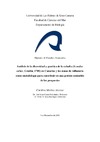Please use this identifier to cite or link to this item:
https://accedacris.ulpgc.es/handle/10553/2946
| Title: | Análisis de la diversidad y genética de la caballa (Scomber colias, Gmelin, 1789) en Canarias y las zonas de influencia como metodología para contribuir en una gestión sostenible de las pesquerías | Authors: | Medina-Alcaraz, Carolina | Director: | Sosa, Pedro A. Castro, J.J. |
UNESCO Clasification: | 240903 Genética de poblaciones | Keywords: | Scomber colias Mackarel Caballa |
Issue Date: | 2009 | Abstract: | Se ha analizado la diversidad genética de tres poblaciones naturales de caballa (Scomber colias, Gmelin, 1789), extraídas por la flota artesanal del Archipiélago Canario mediante el uso de nueve marcadores moleculares (microsatélites). Las muestras fueron capturadas en las costas de Gran Canaria, Tenerife y La Palma. Los resultados preliminares muestran una alta diversidad genética en cada población y un elevado polimorfismo. El número medio de alelos, la heterocigosidad media esperada y la proporción de loci polimórficos para todas las poblaciones fueron 19,95, 0,891 y 100 %, respectivamente. La población de Tenerife presentó el mayor nivel de diversidad genética, siendo la de La Palma la que menos diversidad genética alcanzó. En general, todos los resultados y análisis establecidos indican que la diferenciación genética entre las poblaciones es muy baja. Así, no se detecta diferenciación genética entre las localidades, y la estructura poblacional de Scomber colias par comporta como una unidad panmítica.
ABSTRACT
We have analyzed the genetic diversity of three natural populations of mackerel (Scomber Colias, Gmelin, 1789), take out by the artisanal fleet of the Canary Islands using nine molecular markers (microsatellites). Samples were captured off the coast of Gran Canaria, Tenerife and La Palma. Preliminary results show high genetic diversity in each population and a high polymorphism. The average number of alleles, average expected heterozygosity and the proportion of polymorphic loci for all populations were 19.95, 0.891 and 100% respectively. The population of Tenerife showed the highest level of genetic diversity. La Palma showed the lowest genetic diversity. In general, all results and analisys indicate that genetic differentiation is very low among the localities. Thus, the samples seems to be revealed as a single population, and hence the population, and hence the population structure of Scomber colias acts as a panmitic unit. We have analyzed the genetic diversity of three natural populations of mackerel (Scomber Colias, Gmelin, 1789), take out by the artisanalfleet of the Canary Islandsusing nine molecular markers (microsatellites). Samples were captured off the coastof Gran Canaria, Tenerife and La Palma. Preliminary results show high genetic diversity in each population and a high polymorphism. The average number of alleles, average expected heterozygosity and the proportion of polymorphic loci for all populations were 19.95, 0.891 and 100% respectively. The population of Tenerife showed the highest level of genetic diversity. La Palmashowed the lowestgenetic diversity. In general, all results and analisys indicate that genetic differentiation is very low among thelocalities. Thus, the samples seems to berevealed as a single population, and hence the population, and hence the population structure of Scomber coliasacts as a panmitic unit. |
Description: | Diploma de Estudios Avanzados | Department: | Departamento de Biología | Faculty: | Facultad de Ciencias del Mar | URI: | https://accedacris.ulpgc.es/handle/10553/2946 | ISBN: | 978-84-693-1180-6 |
| Appears in Collections: | Trabajo final de máster |
En el caso de que no encuentre el documento puede ser debido a que el centro o las/os autoras/es no autorizan su publicación. Si tiene verdadero interés en el contenido del mismo, puede dirigirse al director/a o directores/as del trabajo cuyos datos encontrará más arriba.
Show full item recordPage view(s)
209
checked on Feb 22, 2025
Download(s)
102
checked on Feb 22, 2025
Google ScholarTM
Check
Altmetric
Share
Export metadata
This item is licensed under a Creative Commons License

